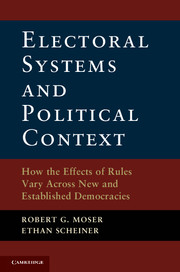 Electoral Systems and Political Context
Electoral Systems and Political Context Book contents
- Frontmatter
- Contents
- Tables and Figures
- Abbreviations
- Glossary of Key Terms
- Acknowledgments and Note on the Online Appendix
- Introduction
- 1 When Do the Effects of Electoral Systems Diverge from Our Expectations?
- 2 Mixed-Member Electoral Systems
- 3 How Democratic Experience and Party System Development Condition the Effects of Electoral Rules on Disproportionality and the Number of Parties
- 4 How Democratic Experience and Party System Development Condition the Effects of Electoral Rules on Disproportionality and the Number of Parties
- 5 Political Context, Electoral Rules, and Their Effects on Strategic and Personal Voting
- 6 How Democratic Experience and Party System Development Condition the Effect of Electoral Rules on Strategic Defection
- 7 Social Diversity, Electoral Rules, and the Number of Parties
- 8 How Political Context Shapes the Effect of Electoral Rules on Women's Representation
- 9 Conclusion
- References
- Index
4 - How Democratic Experience and Party System Development Condition the Effects of Electoral Rules on Disproportionality and the Number of Parties
What We Actually See
Published online by Cambridge University Press: 05 November 2012
- Frontmatter
- Contents
- Tables and Figures
- Abbreviations
- Glossary of Key Terms
- Acknowledgments and Note on the Online Appendix
- Introduction
- 1 When Do the Effects of Electoral Systems Diverge from Our Expectations?
- 2 Mixed-Member Electoral Systems
- 3 How Democratic Experience and Party System Development Condition the Effects of Electoral Rules on Disproportionality and the Number of Parties
- 4 How Democratic Experience and Party System Development Condition the Effects of Electoral Rules on Disproportionality and the Number of Parties
- 5 Political Context, Electoral Rules, and Their Effects on Strategic and Personal Voting
- 6 How Democratic Experience and Party System Development Condition the Effect of Electoral Rules on Strategic Defection
- 7 Social Diversity, Electoral Rules, and the Number of Parties
- 8 How Political Context Shapes the Effect of Electoral Rules on Women's Representation
- 9 Conclusion
- References
- Index
Summary
In Chapter 3, we set up a number of variables and expectations regarding disproportionality and the number of parties. In this chapter, we now take advantage of the simultaneous existence of PR and SMD rules in mixed-member systems across a range of established and new democracies to investigate the extent to which these expectations bear out in reality.
We examine four key electoral outcomes: (1) disproportionality (LSq), the most common measure of the mechanical effect of electoral rules, (2) the constraining effect of SMDs on the number of parties, as measured by the mean effective number of candidates in SMDs (Ncands), (3) the psychological effect, as measured by the difference – within SMDs – between the effective number of parties winning votes under PR balloting and the effective number of candidates winning votes in SMD balloting (Nparties minus Ncands), and (4) the projection of district-level party configurations to the national level, as measured by the nationally aggregated effective number of parties receiving SMD votes and the effective number of candidates at the district level receiving SMD votes (Nv SMD minus Ncands).
In each of these cases, we expect democratic experience and party system development to condition the effects of electoral rules. More specifically, we expect that, compared with established democracies, in new democracies disproportionality will be higher, SMDs will lead to a weaker psychological effect that promotes a larger number of parties, and there will be less matching between the number of parties at the district and national levels. Indeed, in this chapter we find that these expectations bear out.
- Type
- Chapter
- Information
- Electoral Systems and Political ContextHow the Effects of Rules Vary Across New and Established Democracies, pp. 89 - 120Publisher: Cambridge University PressPrint publication year: 2012


